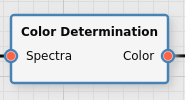Color Determination Filter
Calculates color values from reflectance curves in various color spaces.
Category |
|
Node |
|
Parameters |
Color Space: which color space to output in (see below) Illuminant: which illuminant to assume (only for color spaces that don’t have a fixed illuminant) Standard Observer: which standard observer to assume (only for color spaces that don’t have a fixed observer) |
Inputs |
Spectra: the reflectance data |
Outputs |
Color: the color values in the chosen color space |
Effect of the Filter
This filter will take reflectances in the visible wavelength range and calculate integrals with the color matching functions. It will use values from wavelength ranges from 380nm to 780nm; if the input doesn’t include the entire range, all other values are assumed to be zero.
The result of this filter are three-channel color values in various color spaces. This is an absolute color measurement based on the provided input reflectance spectra. (The quality of the input spectra will dictate how accurate this will be.)
The user may select from one of the following color spaces:
Color Space |
Output Value Ranges |
|---|---|
CIE XYZ |
0.0 to 1.0 |
CIE L*a*b* |
L*:0.0 to 100.0; a*, b*:unbounded, but typically within -150.0 to 150.0 |
CIE L*u*v* |
L*: 0.0 to 100.0; u*, v*: -100.0 to 100.0 |
CIE L*C*h* (from CIE L*a*b*) |
L*: 0.0 to 100.0; C*: positive, typically within 0.0 to 150.0; h*: angle, 0.0 to 360.0 |
Hunter Lab |
L: 0.0 to 100.0; a, b: depends on the illuminant, but will not exceed -200.0 and 200.0 |
sRGB |
0.0 to 1.0 |
Adobe RGB |
0.0 to 1.0 |
CIE RGB |
0.0 to 1.0 |
HSV (associated with any of the RGB spaces) |
H: 0.0 to 360.0; S, V: 0.0 to 1.0 |
The RGB (and associated HSV) color spaces have defined observers and illuminants. The following table shows which observers/illuminants will be chosen if an RGB (or associated HSV) color space is selected:
Color Space |
Illuminant |
Observer |
|---|---|---|
sRGB |
D65 |
2 degrees |
Adobe RGB |
D65 |
2 degrees |
CIE RGB |
E |
2 degrees |
For all other color spaces the user can manually select the illuminant and observer values. (Since a reflectance spectrum contains information about the entire wavelength range, the illuminant used for the measurement doesn’t matter much, as long as it covers the entire wavelength range; and the color space values for any illuminant can be reconstructed from a given spectrum.)
The following illuminants can be used for calculations:
D75
D65
D55
D50
A
C
E
Additionally the user can select the following observers defined by the CIE:
2 degrees (CIE 1931) – used for normal visual field sizes
10 degrees (CIE 1964 supplementary) – used for large visual field sizes in combination with a large light intensity to exclude the usage of rod receptors in the eyes of the observer
